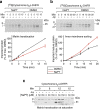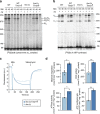Mitochondrial protein sorting as a therapeutic target for ATP synthase disorders
- PMID: 25519239
- PMCID: PMC4284804
- DOI: 10.1038/ncomms6585
Mitochondrial protein sorting as a therapeutic target for ATP synthase disorders
Abstract
Mitochondrial diseases are systemic, prevalent and often fatal; yet treatments remain scarce. Identifying molecular intervention points that can be therapeutically targeted remains a major challenge, which we confronted via a screening assay we developed. Using yeast models of mitochondrial ATP synthase disorders, we screened a drug repurposing library, and applied genomic and biochemical techniques to identify pathways of interest. Here we demonstrate that modulating the sorting of nuclear-encoded proteins into mitochondria, mediated by the TIM23 complex, proves therapeutic in both yeast and patient-derived cells exhibiting ATP synthase deficiency. Targeting TIM23-dependent protein sorting improves an array of phenotypes associated with ATP synthase disorders, including biogenesis and activity of the oxidative phosphorylation machinery. Our study establishes mitochondrial protein sorting as an intervention point for ATP synthase disorders, and because of the central role of this pathway in mitochondrial biogenesis, it holds broad value for the treatment of mitochondrial diseases.
Figures




Similar articles
-
Mitochondrial protein translocases for survival and wellbeing.FEBS Lett. 2014 Aug 1;588(15):2484-95. doi: 10.1016/j.febslet.2014.05.028. Epub 2014 May 24. FEBS Lett. 2014. PMID: 24866464 Review.
-
Oxa1 directly interacts with Atp9 and mediates its assembly into the mitochondrial F1Fo-ATP synthase complex.Mol Biol Cell. 2007 May;18(5):1897-908. doi: 10.1091/mbc.e06-10-0925. Epub 2007 Mar 7. Mol Biol Cell. 2007. PMID: 17344477 Free PMC article.
-
Mitochondrial ATP synthase disorders: molecular mechanisms and the quest for curative therapeutic approaches.Biochim Biophys Acta. 2009 Jan;1793(1):186-99. doi: 10.1016/j.bbamcr.2008.06.012. Epub 2008 Jun 20. Biochim Biophys Acta. 2009. PMID: 18620007 Review.
-
ATP Synthase Subunit a Supports Permeability Transition in Yeast Lacking Dimerization Subunits and Modulates yPTP Conductance.Cell Physiol Biochem. 2020 Feb 27;54(2):211-229. doi: 10.33594/000000215. Cell Physiol Biochem. 2020. PMID: 32100973
-
Protein Import by the Mitochondrial Presequence Translocase in the Absence of a Membrane Potential.J Mol Biol. 2016 Mar 27;428(6):1041-1052. doi: 10.1016/j.jmb.2016.01.020. Epub 2016 Jan 29. J Mol Biol. 2016. PMID: 26827728
Cited by
-
Yeast as a Model to Find New Drugs and Drug Targets for VPS13-Dependent Neurodegenerative Diseases.Int J Mol Sci. 2022 May 4;23(9):5106. doi: 10.3390/ijms23095106. Int J Mol Sci. 2022. PMID: 35563497 Free PMC article. Review.
-
DNA polymerase γ and disease: what we have learned from yeast.Front Genet. 2015 Mar 17;6:106. doi: 10.3389/fgene.2015.00106. eCollection 2015. Front Genet. 2015. PMID: 25852747 Free PMC article. Review.
-
Yeast as a system for modeling mitochondrial disease mechanisms and discovering therapies.Dis Model Mech. 2015 Jun;8(6):509-26. doi: 10.1242/dmm.020438. Dis Model Mech. 2015. PMID: 26035862 Free PMC article. Review.
-
Assembly-dependent translation of subunits 6 (Atp6) and 9 (Atp9) of ATP synthase in yeast mitochondria.Genetics. 2022 Mar 3;220(3):iyac007. doi: 10.1093/genetics/iyac007. Genetics. 2022. PMID: 35100419 Free PMC article.
-
Drug Drop Test: How to Quickly Identify Potential Therapeutic Compounds for Mitochondrial Diseases Using Yeast Saccharomyces cerevisiae.Int J Mol Sci. 2023 Jun 27;24(13):10696. doi: 10.3390/ijms241310696. Int J Mol Sci. 2023. PMID: 37445873 Free PMC article. Review.
References
-
- Houstek J. et al.. Mitochondrial diseases and genetic defects of ATP synthase. Biochim. Biophys. Acta 1757, 1400–1405 (2006). - PubMed
Publication types
MeSH terms
Substances
Grants and funding
LinkOut - more resources
Full Text Sources
Other Literature Sources
Medical
Molecular Biology Databases

